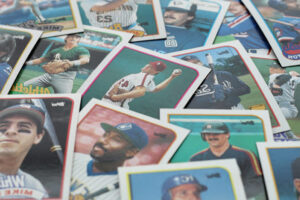Whether you’ve just started collecting sports cards or are a seasoned collector, you should have some basic knowledge of sports card grading. In the other article (see our blog), we broke this topic down based on physical condition and appearance (e.g., surface, corners, edges). Here, we’ll talk about other factors like brand and year.
But first, let’s get familiar with grading companies and scales:
Grading Companies
Beckett Grading Services (BGS), Professional Sports Authenticator (PSA), and SGC (Sportscard Guaranty Corporation) are the most trusted third-party trading card authentication and grading companies worldwide. Generally, BGS is preferred for modern cards, while PSA is a good choice for vintage cards.
Grading Scales
BGS grades sports cards on a scale of 1-10 with subgrades of 0.5s. PSA has a similar grading system but a flat scale of 1-10. SGC ratings are done on a scale of 100, which is then used to grade the card from 1-10.
Cards are scored based on their centering, corners, edges, and surface. Each card is scored on a scale of 1-10, and then they’re combined to give the card a final grade, also in the [1-10] range. Any grade above a nine is worth the book value or even more, as BGS 9 – also known as “Mint 9” – reflects the condition expected for the card out of the pack. A grade of 9.5 is Gem-Mint, meaning a nearly flawless card. A grade of 9.5 is what most collectors want. There’s also a “PRISTINE 10,” which is the holy grail of the box. Although Pristine 10s are rare, they can turn a $10 card into a $1,000 card.
Brand
This probably confuses people the most.
If you expect certain card brands to score high, you’re overly optimistic and wishing for something practically impossible. Take Derek Jeter’s 1993 SP rookie card, for example. The cards were made from foil material, resulting in an insane amount of “out of the pack” imperfections. As a result, high grades sell for thousands, while average grades go for much less.
Year
This concept is quite simple, as older cards tend to grade lower than newer ones. This doesn’t mean that older cards are worth less; it simply indicates that older cards can be expected to be of lower quality in terms of condition. The condition is due to a number of factors including age, wear and tear, and more frequent handling. Older cards can be found in excellent condition although this is much less common than with modern cards.
Bottom Line
While careful examination of trading cards requires technical knowledge and specialized tools, card collectors will have some understanding of grade and quality after some time. The more you read and gain experience, the more accurate estimations you can make.
Our experts at American Legends will tell you how valuable your card is by taking a quick look at it. Contact us and speak with them if you want to sell your cards.


